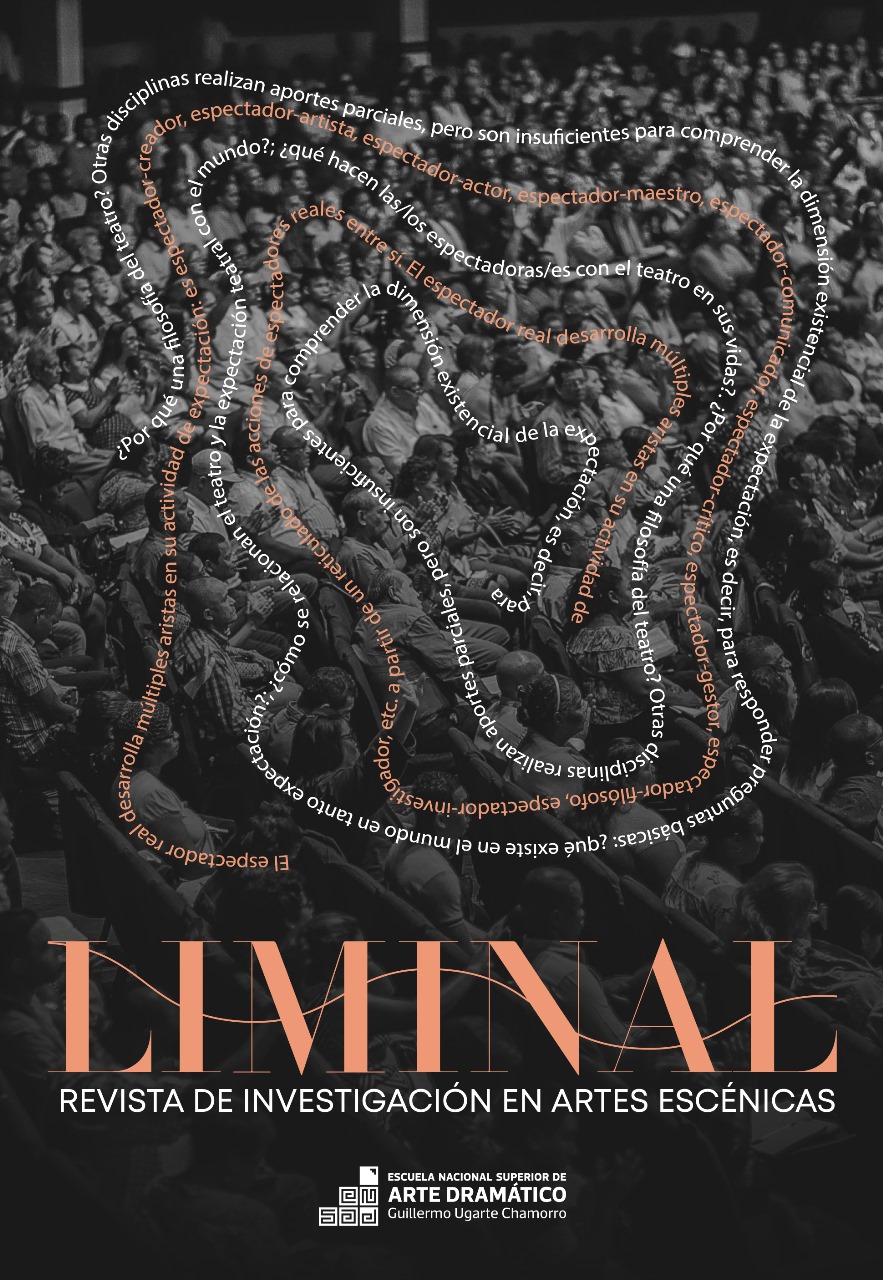Retórica escénica y la relación entre espectáculo teatral y espectadores
una creencia lúdica para el placer
DOI:
https://doi.org/10.69746/liminal.a16Keywords:
theatrical technique, playful belief, verisimilitude, scenic rhetoric, scene/spectators solidarityAbstract
This work involves a limited series of considerations on the modes of scenic seduction and the construction of an aesthetic belief in the spectator. In this sense, its aim is to demonstrate the mutual interdependence, complementarity and solidarity between the scenic agency and its active sensory reception. Therefore, audience configurations are analyzed taking into account the unavoidable relationship between perceptual trends, its consumption habits and scenic procedures. For that reason, this work proposes to examine hermeneutics and frequent semiotic and semantic performance approaches to analyze and reformulate certain job stereotypes from a rhetoric (in its basic emotional and somatic aspect) and phenomenal perspective. For this purpose, this work briefly discussed theatrical theory and rhetoric sources which enable the assumption that the theatrical theory, and the resulting strategies of verisimilitude and empathy are decisive factors for the constitution of the role of the “spectator”.
It is considered that the back-and-forth processes in the ephemeral nature of the convivial situation are sustained by the playful belief of the audience to the extent that it is addressed, from the scene and its dynamics (acting, staging, direction), the need for a spectator enjoyment, that is to say, a basic belief and a pleasurable aesthetic experience for those who play the role of spectators, which originates from the sensation that the duality of reality and fiction playfully merges: playing at “believing” as in a contract.
Downloads
References
Aristóteles (1971). Retórica. Instituto de Estudios Políticos.
Austin, J. L. (1962). How to do Things with Words. Clarendon Press.
Barba, E. (2010). Quemar la casa. Orígenes de un director. Catálogos.
Barba, E. y N. Savarese (1990). El arte secreto del actor. Escenología-UNAM.
Cicero, M. T. (1966). Brutus. Ed. Douglas, A. E. Clarendon Press.
Cicero, M. T. (1996). De oratore. Translated by Sutton, E. & Rackham, H. Harvard UP. Loeb Classical Library.
Cicero, M. T. (1989). Orator. Recognovit brevique adnotatione critica instruxit Wilkins, A. S. Oxford University Press.
De Marinis, M. (2005). En busca del actor y del espectador. Comprender el teatro II. Galerna.
Diderot, D. (2006). Paradoja del comediante. Losada.
Dubatti, J. (2014). Filosofía del Teatro III. El teatro de los muertos. Atuel.
Dubatti, J. (2003). El convivio teatral. Teoría y práctica del Teatro Comparado. Atuel.
Eisenstein, S. (1986). Il montaggio delle attrazioni en P. Montani (Ed.), Il montaggio. Marsilio, pp. 219-225.
Falletti, C. (et al.) (2010). Diálogos entre Teatro y Neurociencias. Artezblai.
Gómez, C. (2013). La suspensión de la incredulidad −entre ficción y pragmática−. Conceptual. Estudios de Psicoanálisis, 14. https://aplp.org.ar/conceptual/conceptual-n-14-estudios-de-psicoanalisis/
Grotowski, J. (1986). Hacia un teatro pobre. Siglo XXI.
Helbo, A. (1989). Teoría del espectáculo. El paradigma espectacular. Galerna-Lemcke Verlag.
Horacio (2012). Arte poética. Introducción, traducción, notas y comentario de Juan Antonio González Iglesias. Cátedra.
Jauss, H.R. (1978). Pour une esthétique de la réception. Gallimard.
Lipps, T. (1924). Aesthetik, [1903-1906]. Los Fundamentos de la estética. T. I y II. Trad. esp. de Ovejero Maury. Daniel Jorro. Teubner.
Maingueneau, D. (1980). Introducción a los métodos de análisis del discurso: problemas y perspectiva. Hachette.
Pericot, J. (1987). Servirse de la imagen. Ariel.
Pricco, A. (2015). Sostener la inquietud. Teoría y práctica de la actuación teatral según una retórica escénica. Biblos/UNR Editora.
Quintiliano, M. F. (1942). Instituciones Oratorias. Hernando.
Q. Horatius Flaccus (1934). Carmina. B.G. Teubner.
Rancière, J. (2010). El espectador emancipado. Manantial.
Salabert, P. (2013). Teoría de la creación en el arte. Akal.
Salabert, P. (1995). El amor pasional. Una intención y veinte razones, en L. Area, G. Ortiz (Comp.), Pasiones en el siglo XX. Homo Sapiens, pp. 11-51.
Salabert, P. (1990). La mirada en el vacío. Ensayos de estética y semiótica, Poetica et Analytica Nº 9. Aarhus Universitet: Almen Semiotik, pp. 85-106.
Sofía, G. (2015). Las acrobacias del espectador. Neurociencias y teatro, y viceversa. Paso de gato-Artezblai.
Stanislavski, C. (1979). Obras completas. El trabajo del actor sobre sí mismo en el proceso creador de la encarnación. Quetzal.
Tatarkiewicz, W. (1976). Historia de seis ideas. Tecnos.
Ubersfeld, A. (1987). Semiótica teatral. Cátedra.
Valenzuela, J. L. (2016). Entrando impunemente en obras ajenas. INT.
Vischer, F. (1873). Über das optische Formgefühl, ein Beitrag zur Ästhetik. Galler














